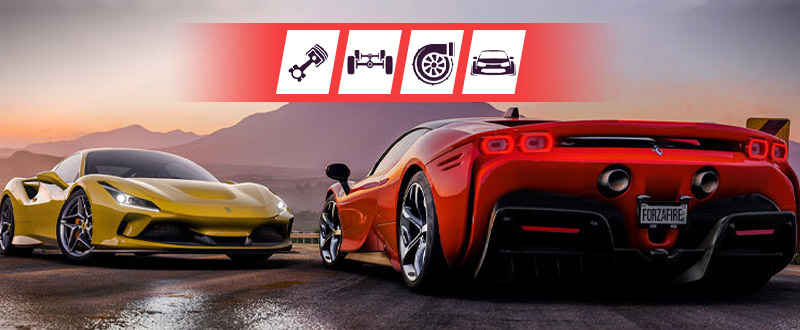Conversion Tuning Guide

Forza Horizon 5 tuning is as complex as it is important for reaching the maximum potential of your car. It’s a difficult skill to master, but once you’ve got the hang of it and are finally able to tune your favourite cars on your own, it’s going to feel very satisfying and worth the effort!
In this guide we'll focus on the conversion options and how to effectively upgrade them.
This guide was created with help from the following tuners:
In this guide we'll focus on the conversion options and how to effectively upgrade them.
This guide was created with help from the following tuners:
- snosaes - a highly experienced player and member of 1%, who holds multiple world records for various tracks and also maintains popular community spreadsheets (e.g. Horizon World Records)
Engine Swap
Engine swapping a car will usually result in better overall performance. In the end, what you should be looking for is the engine that gives the best power-to-weight (P/W) ratio.
Some engines are more PI (Performance Index) efficient than others. These engines include:
- Racing V12
- 6.2L V8 (415hp)
- 7.2L Racing V8
- 5.2L V10
- V10
- 4.0L V8
- 3.2L I6
- 1.6L I4 - VVT
- 2.0L F4 - Turbo Rally
Aspiration
In addition to engine swaps, there are also aspiration swaps. Typically, Centrifugal Superchargers are the most PI efficient, but it is worth experimenting with Single/Twin Turbos and Positive-Displacement Superchargers as they can occasionally result in a better P/W ratio, and some engines do not have the Centrifugal Supercharger as an option.
Drivetrain
When it comes to drivetrains, each of them (AWD, RWD, FWD) have their pros and cons. It is car, class and track dependent as to which drivetrain you should be using.
AWD (all wheel drive) is the drivetrain players most commonly use, but it is not always the best choice. When it comes to a car that comes stock as AWD, you should always keep it as AWD. However, as a swap, converting to AWD is not always the most efficient.
The Pros of AWD are:
- Cars that are AWD swapped will have the same shift time on Manual as they do on Manual w/ Clutch;
- Has better corner exit acceleration than RWD and FWD;
- Has better launch than RWD and FWD;
- More overall traction;
- Used on almost every dirt/cross country car as a result of having more traction;
- Doesn’t require throttle control;
- Overall easier to drive, making it easier to get pace out of;
- Works in B, A, S1 and S2;
- Heavier than RWD and FWD;
- Can add a lot of PI depending on the car;
- Less top end than 2WD (RWD and FWD);
- Less turn-in than FWD;
- More understeer than RWD;
- Isn’t able to be powerbuilt (a build using weaker tires in order to get high amounts of power to be used on sprints/acceleration tracks);
- Uncompetitive in D and C;
RWD (rear wheel drive) is the drivetrain that is most dominant overall in the game. RWD cars are able to be powerbuilt due to the PI system allowing for RWD (and FWD) cars on weaker tires to get high amounts of power, resulting in very high top end and acceleration relative to its class. These powerbuilds often claim many of the fastest times in rivals, due to most of the tracks favoring cars with high acceleration and top end over grip.
The Pros of RWD are:
- Lighter than AWD;
- Usually more PI efficient than AWD;
- Faster on launch than FWD;
- More top end than AWD;
- Less understeer than AWD;
- Less on-throttle understeer than FWD;
- Able to be powerbuilt;
- Works in every class;
- Requires Manual w/ Clutch to get maximum pace out of, lots of time is lost on shifting without it;
- Requires throttle control;
- Slower on launch and corner exit than AWD;
- Powerbuilds can be difficult to drive;
- RWD swap is useless;
FWD (front wheel drive) is the least common drivetrain used as it serves as more of a situational niche compared to RWD and AWD. FWD cars, like RWD, can be powerbuilt, but aren’t as competitive as RWD powerbuilds.
The Pros of FWD are:
- Lighter than AWD;
- More turn-in than RWD and AWD;
- Able to be powerbuilt;
- Works in D, C, B and A;
- Either needs to be full handling or full powerbuild, no in between;
- Requires Manual w/ Clutch to get maximum pace out of, lots of time is lost on shifting without it;
- Requires throttle control;
- Slower on launch than RWD, much slower on launch than AWD;
- Slower on corner exit than AWD;
- FWD cars often don’t get good engine swaps (usually only 2.0L I4 - Turbo Rally and/or 2.0L I4 - VVT);
- On-throttle understeer;
- Doesn’t work above A class;
Body Kits
Lastly, widebody kits increase the max tire width and increase the track width of a car, increasing grip and stability, at a cost of adding drag. However, some widebodies, such as the one on the 2008 Mitsubishi Lancer Evolution X GSR, add too much drag to be worth using. Widebody kits can also sometimes add adjustable downforce. Depending on the car, they will either add or remove weight.
Thank you for taking the time to read our guide and we hope it provided you with helpful information! If you have any feedback or questions, or if you would like to contribute to our guides yourself, feel free to reach out to us on Discord!










